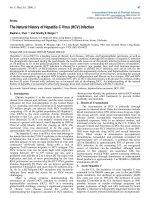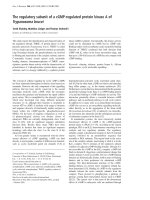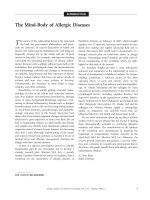Báo cáo y học: " The natural history of West Nile virus infection presenting with West Nile virus meningoencephalitis in a man with a prolonged illness: a case report" doc
Bạn đang xem bản rút gọn của tài liệu. Xem và tải ngay bản đầy đủ của tài liệu tại đây (662.59 KB, 4 trang )
CAS E REP O R T Open Access
The natural history of West Nile virus infection
presenting with West Nile virus
meningoencephalitis in a man with a prolonged
illness: a case report
Shraddha Mainali
1
, Mansoor Afshani
1
, James B Wood
3
and Michael C Levin
1,2*
Abstract
Introduction: Estimates indicate that West Nile virus infects approximately one and a half million people in the
United States of America. Up to 1% may develop West Nile virus neuroinvasive disease, in which infected patients
develop any combination of meningitis, encephalitis, or acute paralysis.
Case presentation: A 56-year-old African-A merican man presented to our hospital with headache, restlessness,
fever, myalgias, decreased appetite, and progressive confusion. A cerebrospinal fluid examination sho wed mild
leukocytosis and an elevated protein level. Testing for routine infections was negative. Brain T2-weighted magnetic
resonance imaging scans showed marked enlargement of caudate nuclei and increased intensity within the basal
ganglia and thalami. A West Nile virus titer was positive, and serial brain magnetic resonance imaging scans
showed resolving abnormalities that paralleled his neurological examination.
Conclusion: This report is unusual as it portrays the natural history and long-term consequences of West Nile virus
meningoencephalitis diagnosed on the basis of serial brain images.
Introduction
West Nile virus (WNV) is an arthropod-borne flavivirus
transmitted to humans by the bite of an infected mosquito
[1,2]. The flavivirus belongs to the Japanese encephalitis
virus antigenic complex, which was first isol ated from a
37-year-old woman living in the West Nile District of
Uganda in 1937 [1]. Sixty-two years later, in the summer
of 1999, the virus was first identified in the United States
of America, where it appeared during an outbreak of natu-
rally acquired meningitis and encephalitis in the New
York City area [3].
WNV infection typically peaksinlateJulythrough
early September [4]. The disease usually presents with
three clinical syndromes: asymptomatic infection, mild
febrile syndrome (WNV fever), and neuroinvasive dis-
ease. The majority of people infected are asymptomatic
[4,5]. Approximately 20% of people who are infected with
WNV develop WNV fever, which presents as a flulike ill-
ness (headache, malaise, myalgias, and lymphadenopathy)
and a non-specific maculopapular rash involving the
neck, trunk, arms, and legs [5]. About 1% of WNV infec-
tions result in WNV neuroinvasive disease (WNND),
defined by evidence of WNV infection with any combina-
tion of meningiti s, encephalitis, or acute flaccid paralysis
or poliolike syndrome [5].
In 1999, the Centers for Disease Control and Preven-
tion (CDC) reported a total of 62 WNV infections, of
which 59 presented with WNND [4]. There were seven
fatalities. The number of WNND cases peaked in 2002.
That year there were 2946 WNND cases and 284 deaths
[4]. The latest data from the CDC show a total of 21
cases of WNND with two deaths in 2010 [6]. It has been
reported that the i ncidence of WNND ranges between
1:140 and 1:256 among people infected with WNV [4 ].
By extrapolation, the virus has infected more than one
and a half million people in the United States of America,
and the long-term disability following WNND is just
beginning to be appreciated [4,7,8]. We present a case of
* Correspondence:
1
Department of Neurology, University of Tennessee Health Science Center,
Memphis, TN 38163, USA
Full list of author information is available at the end of the article
Mainali et al. Journal of Medical Case Reports 2011, 5:204
/>JOURNAL OF MEDICAL
CASE REPORTS
© 2011 Mainali et al; licensee BioMed Central Ltd. This is an Open Access article distributed under the terms of the Creative Commons
Attribution License ( which permits unrestricted use, distribution, and reprod uction in
any medium, prov ided the orig inal work is properly cited.
one of the survivors of WNND. The significance of this
case is that seria l brain magnetic resonance imaging
(MRI) scans were obtained which correlated with the
clinical course of the disease, hence supporting the use of
brain MRI in rendering a preliminary diagnosis and
following the progression of WNND.
Case presentation
A 56-year-old African-American man with a history of
hypertension and chronic hepatitis C virus infection pre-
sented to the e mergenc y room with a three-day history
of flulike symptoms, including fever, myalgias, headache,
and decreased appetite. His vital signs were blood pres-
sure 204/104 mmHg, pulse 90 beats/m inute, respiratory
rate 14 breaths/minute, and peak temperature 105.2°F.
His physical examination was notable for restlessness
and confusion. There was neck rigidity. Papilledema was
not present. He could not follow commands, and mild
right hemiparesis was noted. Computed tomography of
the brain showed a subtle, low-density signal of the cau-
date nuclei bilaterally (not shown). His serum laboratory
values were normal except for mild leukocytosis, with a
total white blood cell count of 10,400/mm
3
comprising
82% neutrophils, 9% monocytes, and 8% lymphocytes.
His cerebrospinal fluid (CSF) examination showed white
blood cell count of 29/mm
3
, comprising 81% lympho-
cytes, 15% neutrophils, 4% monocytes, 87 mg/dl protein,
and 63 mg/dl glucose. We performed CSF Gr am stain-
ing, ac id-fast bacilli staining, a meningitis screen (Neis-
seria meningitidis, group B Streptococcus, Streptococcus
pneumoniae,andHaemophilus influenzae type b), a
cryptococcal antigen test, and a Venereal Disease
Research Laboratory test, all of which were negative.
He was admitted to the intensive care unit in a stupor.
He was treated with broad-spectrum antibiotics (vancomy-
cin, ceftriaxone, ampicillin, and tetracycline) and intrave-
nous acyclovir. Laboratory evaluations for herpes simplex
virus (HSV)-1 and HSV-2, tuberculosis (TB), cytomegalo-
virus (CMV), and WNV were sent. On day two, an elec-
troencephalogram showed diffuse slowing without seizure
activity. A brain MRI performed on the same day demon-
strated markedly enlarged caudate nuclei and increased
intensity of caudate, lenticular nuclei and the thalamus on
T2-weighted images (Figure 1A). T1-weighted images
showed a subtle, low-intensity signal within the lesions,
and the lesions did not enhance following gadolinium
infusion (not shown). He continued to have fever and con-
fusion with a waxing and waning men tal status. Polymer-
ase chain reaction studies of his CSF for HSV, TB, and
CMV were negative. His blood, urine, and CSF cultures
were negative. By day seven, his mental status had
improved to the point that he was oriented to himself and
could state his age. From hospital days eight to 16, he
showed slow improvement with phases of intermittent
confusion. On day 13, a brain MRI scan (Figure 1B)
showed decreased edema in the basal ganglia and thala-
mus as compared to the prior MRI scans.
On day 19, he was fully oriented, and his mental status
appeared to have returned to baseline. His WNV immu-
noglobulin M (IgM) titer at that time was positive (acute
and convalescent phase). A brain MRI scan (Figure 1C)
obtained on day 21 revealed resolving inflammatory
changes in the basal ganglia and thalamus. Six weeks
later he was fully oriented to time, place, and person and
did not articulate any complaints. Another brain MRI
scan (Figure 1D) showed resolving basal ganglia and t ha-
lamus edema with persistent hyperintense changes in
both structures. Approximately one year later he was
diagnosed with depression. Four years later formal
neuropsychological and neurological evaluations showed
evidence of difficulties with motor and mental processing
speed and residual, mild right hemiparesis.
Discussion
This case exemplifies a form of WNND presenting as
WNV meningoen cephalitis. The most reliable diagnost ic
modality for WNV infection is the detection of serum
IgM antibody to WNV in his serum collected within
eight to 14 days of presentation or CSF collected within
eight days of the onset of illness using IgM antibody cap-
ture enzyme-linked immunos orbent assay [5]. Consider-
ing the relativ ely long interval between the sample
collection and reporting of the definitive test, alternative
methods of diagnosis would be helpful in prompt man-
agement of the disease. In our patient, we found that the
brain MRI findings (bilateral edema and hyperintensity of
the basal ganglia and thalami) were helpful in this clinical
setting to establish a preliminary diagnosis of WNND.
Further, since clinical improvement correlated with resol-
ving changes on serial brain MRI scans, his prognosis
could also be assessed. Criti cally, the brain MRI scan did
not return to normal, nor did he, indicative of the long-
last ing effects of WNND, which include residual psycho-
logical and psychiatric disease [7-9]. Consistent with
these observations, our patient developed cognitive dys-
function with depression and is still undergoing outpati-
ent psychological treatment. Of note, these MRI findings
are not specific to WNV encephalitis. Other viral ill-
nesses such as Japanese encephalitis virus and St Louis
encephalitis virus can show similar findings; thus brain
MRI cannot be the sole diagnost ic modality for detecting
WNND [2]. For example, recent data indi cate that chor-
ioretinitis may be a marker of WNND [10]. However, if
other risk factors such as geographic location (WNV pre-
dominant locations), history of exposure to mosquitoes,
and the time of the year are considered, brain MRI can
be useful for establishing an early diagnosis and treat-
ment plan while the definitive test is pending.
Mainali et al. Journal of Medical Case Reports 2011, 5:204
/>Page 2 of 4
Conclusion
Characteristic patterns of serial brain MRI scans in
patients with WNND can provide an early clinical clue
as to the diagnosis and prognosis while awaiting defini-
tive laboratory testing.
Consent
Written informed consent was obtained from the patient
for publication of this case report and any accompanying
images. A copy of the written consent is available for
review by the Editor-in-Chief of this journal.
Abbreviations
CDC: Centers for Disease Control and Prevention; CMV: cytomegalovirus; CSF:
cerebrospinal fluid; HSV: herpes simplex virus; MRI: magnetic resonance
imaging; TB: tuberculosis; WNND: West Nile virus neuroinvasive disease;
WNV: West Nile virus.
Acknowledgements
This material is the result of work supported with resources and use of the
facilities at the Veterans Administration Medical Center, Memphis, TN.
Author details
1
Department of Neurology, University of Tennessee Health Science Center,
Memphis, TN 38163, USA.
2
Neurology Service, Veterans Administration
Medical Center, Memphis, TN, USA.
3
Radiology Services, Veterans
Administration Medical Center, Memphis, TN, USA.
Authors’ contributions
SM and MA analyzed and interpreted the patient data regarding the clinical
presentation and were major contributors in writing the manuscript. JW
performed and interpreted the MRI data. MCL reviewed all of the data and
made major contributions to the writing and editing of the manuscript. All
authors read and approved the final manuscript.
Figure 1 Serial brain magnetic resonance imaging (MRI) sca ns obtained duri ng the course of the patient’ sillness. (A) Day 2: T2-
weighted MRI scan demonstrates markedly enlarged caudate nuclei (arrows) and increased intensity in the thalami (arrowheads). (B) Eleven days
after his initial presentation the abnormalities were resolving (arrows and arrowheads). Of note, the lenticular nucleus was involved (asterisk). (C)
Three weeks and (D) two months after his initial presentation the abnormalities continued to improve, but had not resolved completely (arrows,
arrowheads). Incidental hypertensive hemorrhage was present (black arrowhead in Figure 1C).
Mainali et al. Journal of Medical Case Reports 2011, 5:204
/>Page 3 of 4
Competing interests
The authors declare that they have no competing interests.
Received: 30 August 2010 Accepted: 25 May 2011
Published: 25 May 2011
References
1. KL Tyler, West Nile virus encephalitis in America. N Engl J Med. 344,
1858–1859 (2001). doi:10.1056/NEJM200106143442409
2. T Solomon, Flavivirus encephalitis. N Engl J Med. 351, 370–378 (2004).
doi:10.1056/NEJMra030476
3. D Nash, F Mostashari, A Fine, J Miller, D O’Leary, K Murray, A Huang, A
Rosenberg, A Greenberg, M Sherman, S Wong, M Layton, The outbreak of
West Nile virus infection in the New York City area in 1999. N Engl J Med.
344, 1807–1814 (2001). doi:10.1056/NEJM200106143442401
4. LR Petersen, EB Hayes, West Nile virus in the Americas. Med Clin North Am
92, 1307–1322 (2008). ix. doi:10.1016/j.mcna.2008.07.004
5. LE Davis, R DeBiasi, DE Goade, KY Haaland, JA Harrington, JB Harnar, SA
Pergam, MK King, BK DeMasters, KL Tyler, West Nile virus neuroinvasive
disease. Ann Neurol. 60, 286–300 (2006). doi:10.1002/ana.20959
6. Centers for Disease Control and Prevention, Division of Vector-Borne
Infectious Diseases, West Nile virus: fight the bite! />ncidod/dvbid/westnile/index.htm
7. R Voelker, Effects of West Nile virus may persist. JAMA. 299, 2135–2136
(2008). doi:10.1001/jama.299.18.2135
8. K Murray, C Walker, E Herrington, JA Lewis, J McCormick, DW Beasley, RB
Tesh, S Fisher-Hoch, Persistent infection with West Nile virus years after
initial infection. J Infect Dis. 201,2–4 (2010). doi:10.1086/648731
9. KO Murray, M Resnick, V Miller, Depression after infection with West Nile
virus. Emerg Infect Dis. 13, 479–481 (2007). doi:10.3201/eid1303.060602
10. F Abroug, L Ouanes-Besbes, M Letaief, F Ben Romdhane, M Khairallah, H
Triki, N Bouzouiaia, A cluster study of predictors of severe West Nile virus
infection. Mayo Clin Proc. 81,12–16 (2006). doi:10.4065/81.1.12
doi:10.1186/1752-1947-5-204
Cite this article as: Mainali et al.: The natural history of West Nile virus
infection presenting with West Nile virus meningoencephalitis in a man
with a prolo nged illness: a case report. Journal of Medical Case Reports
2011 5:204.
Submit your next manuscript to BioMed Central
and take full advantage of:
• Convenient online submission
• Thorough peer review
• No space constraints or color figure charges
• Immediate publication on acceptance
• Inclusion in PubMed, CAS, Scopus and Google Scholar
• Research which is freely available for redistribution
Submit your manuscript at
www.biomedcentral.com/submit
Mainali et al. Journal of Medical Case Reports 2011, 5:204
/>Page 4 of 4









